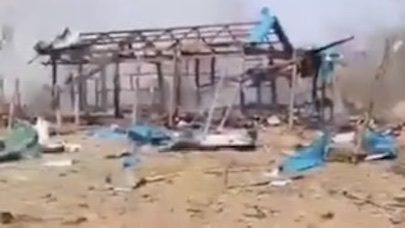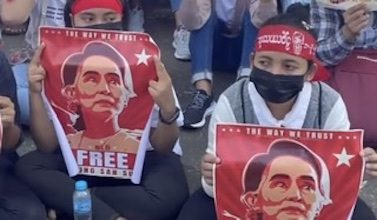Myanmar government airstrike kills many (PDF)
Sawako Uchida, Sawako Utsumi, and Lee Jay Walker
Modern Tokyo Times

Airstrikes by Myanmar in the environs of Pazi Gyi village have reportedly killed over 100 people. This happened during a civilian ceremony accompanied by the People’s Defense Force (PDF).
General Zaw Min Tun admitted that the airstrike was ordered. However, he claims that the attack was chosen because the PDF was intent on creating an office for the local anti-government defense force.
AP reports, “A witness told The Associated Press that a fighter jet dropped bombs directly onto a crowd of people who were gathering at 8 a.m. for the opening of a local office of the country’s opposition movement outside Pazigyi village in Sagaing region’s Kanbalu township. The area is about 110 kilometers (70 miles) north of Mandalay, the country’s second-largest city.”
The Minister of Human Rights at the National Unity Government (Aung Myo Min) said: “Only last week, the UN’s HRC [human rights council] passed a resolution that condemned the junta’s deliberate use of force against civilians and called on the junta to immediately cease all airstrikes. The junta has answered in the only way it knows how – through intensified atrocities and bloodshed.”
Videos also show anti-government forces killing women and men deemed collaborators. Accordingly, while evidence is collected and spread to media agencies concerning atrocities by the armed forces of Myanmar: brutal killings by democratic forces against people deemed to be collaborators are also happening. Therefore, the vicious cycle of violence – all too familiar to Myanmar – is occurring at a heightened level.
Myanmar was beset by ethnic, political, and religious tensions even before the coup against State Counselor Aung San Suu Kyi. However, under the leadership of Min Aung Hlaing (the commander-in-chief of Defence Services): the path to democracy without military interference is a distant dream.
The PDF is believed to have 65,000 members that are regional and ethnic-based.
The United States Institute of Peace reports, “People’s Defense Force is an umbrella term for three types of armed groups that have emerged since the coup: PDFs, Local Defense Forces (LDFs) and People’s Defense Teams (PaKhaPha/PDTs). The PDFs are generally larger armed units formed or recognized by the National Unity Government (NUG), the shadow civilian government formed primarily by democratically elected lawmakers. The PDFs mainly operate under joint command systems established by the NUG and several ethnic armed organizations (EAOs), many of which have been fighting the Sit-Tat for decades. The LDFs are local militias operating autonomously at the local level, often pursuing their own missions separate from the NUG’s. The PDTs are localized guerilla units formed for local defense and security purposes. The PDFs are more regularized military units operating across townships and states/regions, whereas the LDFs and PDTs are self-defense or community security militias operating at the community level.”
The BBC reports, “Thousands have been killed in the civil war, with an additional 1.4 million displaced. Nearly a third of the country’s population is also in need of humanitarian aid, according to the United Nations.”

A timely report by the Special Advisory Council for Myanmar (SAC-M) said: “Through interviews and analysis of shipping records and leaked documents – that dozens of companies based in Austria, France, China, Singapore, India, Israel, Ukraine, Germany, Taiwan, Japan, Russia, South Korea, and the US were supplying raw materials, machines, technology, and parts to the Directorate of Defence Industries (DDI), a state-owned company responsible for producing military equipment for Myanmar’s armed forces.”
The BBC says, “Singapore appears to function as a transit hub, the report says, with Singaporean companies operating as go-betweens for Myanmar’s military buyers and external suppliers.”
Myanmar needs a National Salvation government – even if militants on both sides oppose this.
Accordingly, It is incumbent on the ruling military government to start a new building process that includes Aung San Suu Kyi and the NUG. Indeed, Aung San Suu Kyi is instrumental in restoring a peace process that is badly needed – despite her ongoing persecution in Myanmar.
The status quo will lead to further bloodshed and threaten the survival of Myanmar. Hence, honest brokers in ASEAN and the nations of China, India, Japan, the Russian Federation, and Vietnam need to work together to put respective pressure on competing forces.
If not, the latest airstrike that killed so many will continue unabated – and more people will be forced to flee. This isn’t in the interest of the people of Myanmar. Therefore, the cycle of violence needs to end with all sides compromising: with the onus being on the military government to reach out and end deadly airstrikes.
https://www.usip.org/publications/2022/11/understanding-peoples-defense-forces-myanmar

Modern Tokyo News is part of the Modern Tokyo Times group
http://moderntokyotimes.com Modern Tokyo Times – International News and Japan News
http://sawakoart.com – Sawako Utsumi’s website and Modern Tokyo Times artist
https://moderntokyonews.com Modern Tokyo News – Tokyo News and International News
PLEASE JOIN ON TWITTER
https://twitter.com/MTT_News Modern Tokyo Times
PLEASE JOIN ON FACEBOOK